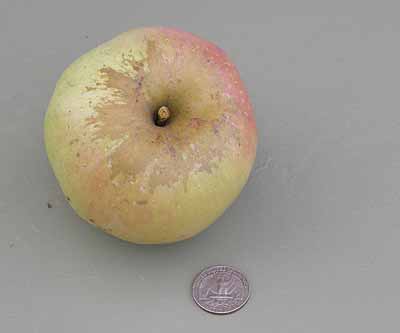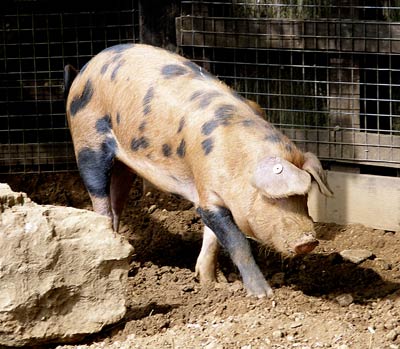
A name for Gloria Mundi, a very large variety of green cooking apple which may have been risen in North American or Germany. There are records in the United States in 1804. It was introduced commercially into the United Kingdom in 1817. This late-season variety is harvested from early October in South-East England and is at its best from October to December. It cooks to a dark golden purée.
A sausage casing made from the large intestine of a pig. These are for large sausages of 10 cm (4 inch) diameter.
A creamy, blue cow's milk cheese first made in 1993. It is sold wrapped in silver foil. This was a Silver Medal winner at 1996 British Cheese Awards.
A variety of red flushed blushed eating apple raised br Mr FW Wastie at Eynsham in Oxfordshire in 1927 as a cross between Blenheim Orange and Court Pendu Plat. This late-season variety is harvested from mid-October in South-East England and is at is best from December to February.

A golden variety of pig with black splotches. The exact origin of the breed is lost in antiquity but the original Oxford Sandy & Black is believed to have developed some two centuries ago in Oxfordshire. The breed declined in numbers dramatically in the 1940s when only one or two boars were licensed. Traditionally it is an outdoor pig used to running free in woodlands, rough grazing and pasture. It would not, however, have been unusual to see it tethered and moved daily to fresh ground as was the custom in the early part of this century. Many pigs of the time were known by names associated with their colour, location or environment and two such names associated with the Oxford Sandy & Black are the "Plum Pudding" and "Oxford Forest" pig. The breed is noted for its many qualities, particularly its excellent temperament and mothering abilities. Generally prolific, the Oxford will function well under most management systems, and produces meat of very high quality and flavour (the markings do not go through to the meat). When crossed with white breeds pure Oxfords produce highly commercial white hybrids.

A golden variety of pig with black splotches. The exact origin of the breed is lost in antiquity but the original Oxford Sandy & Black is believed to have developed some two centuries ago in Oxfordshire. The breed declined in numbers dramatically in the 1940s when only one or two boars were licensed. Traditionally it is an outdoor pig used to running free in woodlands, rough grazing and pasture. It would not, however, have been unusual to see it tethered and moved daily to fresh ground as was the custom in the early part of this century. Many pigs of the time were known by names associated with their colour, location or environment and two such names associated with the Oxford Sandy & Black are the "Plum Pudding" and "Oxford Forest" pig. The breed is noted for its many qualities, particularly its excellent temperament and mothering abilities. Generally prolific, the Oxford will function well under most management systems, and produces meat of very high quality and flavour (the markings do not go through to the meat). When crossed with white breeds pure Oxfords produce highly commercial white hybrids.
A coarse-cut pork sausage made with lemon zest, sage, thyme and marjoram. They can be fried, grilled or baked in the oven.